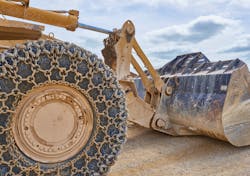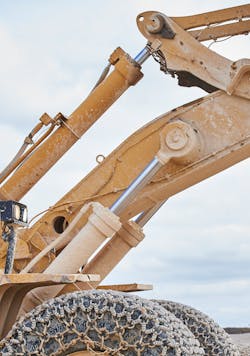Selecting the right hydraulic fluid for an application is critical for several reasons, including its ability to withstand the presence of water. Hydrolytic stability is a hydraulic fluid’s capacity to withstand or resist chemical decomposition when exposed to water.
Water is the most common contaminant in hydraulic fluid said Stephen Gotheridge, technology development manager, Industrial Oils at Lubrizol in an interview with Power & Motion. “Hydraulic fluids are very susceptible to contamination and water is everywhere [which is why] hydrolytic resistance, or stability, is one of the most important characteristics of a hydraulic fluid.”
Why Resistance to Water Matters
Hydraulic fluids must demonstrate a wide range of properties, hydrolytic stability being just one of those, said Gotheridge. And any detrimental change to the fluid, such as exposure to water, will change its properties, leading to performance issues for the hydraulics system and the machine into which it is integrated. “Any hydrolysis of the components within the fluid is basically going to change all those properties that have been designed into the system,” he said.
There are various side effects which can occur due to hydrolytic interaction, including:
- acid generation
- sludge generation
- varnish formation.
These can lead to filters, valves and sensors becoming blocked, impeding hydraulic flow and overall system performance.
In addition, the presence of water in a hydraulic fluid can cause formation of solid particles which he said is well known to be terrible for the performance of lubricants. There are several formations which can occur, including those corrosive to the steel and copper alloys used in hydraulic pumps, circuits and servo valves.
“There are many enemies that can be formed by hydrolysis of the hydraulic fluid,” said Gotheridge.
READ MORE: How To Deal With Water In Hydraulic Oil
How to Ensure Hydrolytic Stability
To maintain the hydrolytic stability of a hydraulic fluid, Gotheridge said everyone working with the fluid plays a part – from a formulator like Lubrizol to the person operating a piece of equipment.
One of the first aspects to take into consideration is environmental factors. If the hydraulic fluid is used in a wet environment, it is important to ensure proper sealing technology is utilized as well as storage of the fluid.
Ensuring proper storage of hydraulic fluid is important to preventing the presence of water. Though a new hydraulic fluid may arrive to a customer free of water, if there is any humidity or other issues with the storage conditions then water could get into the fluid. “You've got to ensure that when you put the new hydraulic fluid into the system, that it does not have a higher water content than desired,” said Gotheridge. “Taking a water sample and analyzing that on a new oil is critical.”
There are also important steps to follow when changing the fluid including fully draining the old fluid or doing so as much as practically possible said Gotheridge. This is important to do because there could be contaminated hydraulic fluid in the system; removing as much of it as possible will ensure the newly added fluid will not be contaminated as well.
In addition, it is important to regularly maintain seals and breathers on the oil reservoir as they are important components to preventing exposure to water.
READ MORE: Avoiding Lubricant Contamination
Monitoring lubricants in service can help to assure hydrolytic stability is maintained as well. Gotheridge said this is done by regularly taking water samples out of the hydraulic fluid and sending them to a laboratory for analysis to ensure there are not large amounts of water in the fluid. He noted this type of condition monitoring is common within hydraulics and most industrial applications. “It’s a very practical in-use operation to make sure you don’t promote hydrolytic susceptibility.”
For fluid formulators like Lubrizol, there are various mechanisms which can be used to ensure hydrolytic stability. Among those is making fluids that can demulse, or shed, water. “We deliberately add components called demulsifiers to the formulation to separate water – whether it be free water, disperse water or tight emulsion water within the actual oil phase,” said Gotheridge.
One of the challenges for formulators is ensuring hydrolytic stability while also considering the other chemistries which need to be included to provide desired performance properties such as anti-wear and anti-corrosion. If the right chemistries are not selected, they could inhibit the fluid’s hydrolytic stability. “It may be that we have to exclude some really good chemistries – some of the best anti-wears may be hydrolytically unstable – because we know it’s going to predominate in the hydrolytic mechanism,” said Gotheridge.
“It’s a very carefully balanced formulation – it’s got the right chemistry for a balanced portfolio of performance [and] it’s not hydrolytically unstable; it can shed water should the system be contaminated,” he said.
Choosing the Right Hydraulic Fluid
Ensuring hydrolytic stability is an important aspect for those developing hydraulic systems and the machines in which they’ll be utilized as well. They too need to consider the type of environment in which the system will be used and if there is the ability to drain water from a hydraulic system should there be any which enters it.
“It’s a decision whether to use a demulsifying fluid or an emulsifying fluid,” said Gotheridge. While some OEMs stipulate the use of an emulsifying chemistry, he said the majority of the market specifies use of a demulsifying fluid. “The bulk of the hydraulic fluid market is demulsifying,” because of the need to shed water, he noted.
demulsifying = separate water from oil molecules
emulsifying = creation of stable arrangement between water and oil molecules
“There is no in between in terms of performance because otherwise you end up with globules of water floating around the system which any lubricant specialist knows is disastrous,” he added.
While the hydraulic circuit design can help with hydrolytic stability – such as through the inclusion of water drain ports and giving the lubricant time to relax in the oil reservoir so it can demulse naturally – the formulation of the hydraulic fluid is critical. As such, it is important for designers to select the appropriate fluid for a given application.
One of the main hurdles associated with hydrolytic stability is educating the industry about it and what options are available in the market. “A lot of people know the different brand names, but they don’t know how they interrelate and perform in terms of exposure to water,” said Gotheridge. “It’s sort of a hidden must have.”
He noted it is possible to have very hydrolytically unstable fluids in the market and make basic performance claims. Currently, OEMs are the ones stipulating certain levels of hydrolytic performance for their equipment using tests such as ASTM D2619, ASTM D4310, and ASTM D943. These tests look at different aspects of contamination from water such as corrosion, sludge and lifetime oxidation.
In general, there is no industry standard for hydrolytic stability. It’s up to OEMs to specify their requirements and design teams to choose the right fluid for an application.
Gotheridge concluded by emphasizing the need for designers and users of hydraulic equipment to consider hydraulic fluid as a critical component to overall performance. “This fluid has to go around the entire system,” he said. “Please consider it as a critical design item when selecting fluids with regard to hydrolytic stability.”





